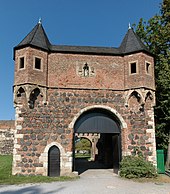Slip gate

A hatch is a small, narrow door that is located next to or in a large castle or town gate. The purpose of these gates was to avoid having to open the large and mostly double-winged castle and city gates for individual pedestrians , as their dimensions were intended for the passage of wagons, carriages and riders and thus represented a potential safety risk. Because only one person at a time was allowed access to the castle or town through the narrow and man-wide hatch , this also made it easier for the guards to control. In the Middle Ages , the narrow doors in the city walls were also used to allow late arrivals to enter after the gates had closed.
If the small inlet is in the wing of a large gate and has a high threshold , it is also called a manhole (also called a manhole or man gate ). If it is a separate narrow entrance next to the large gate, the term pedestrian gate is also common. However, this type of double entrance is rather rare and is only worthwhile in large complexes with lively comings and goings. You can find them on the Alsatian castle Hohlandsberg , the stronghold in Emmendingen , the castle Friedestrom in the Electorate of Cologne and the castle Schaunberg . The narrower side entrance could be secured with its own drawbridge and sometimes even led into a separate gate hall from the larger one ; for example at Hohenwang Castle in Austria.
The hatch gates, which are clearly visible to everyone, are to be distinguished from the small, hidden escape gates in the castle and fortress walls . In the event of a siege, these small openings in the wall were used for escape or military action .
See also
literature
- Friedrich-Wilhelm Krahe: Castles of the German Middle Ages. Floor plan dictionary . Flechsig, Würzburg 2000, ISBN 3-88189-360-1 , p. 24.
- Friedrich-Wilhelm Krahe: Castles and residential towers of the German Middle Ages . Thorbecke, Stuttgart 2002, ISBN 3-7995-0104-5 , p. 28.
- Slip gate . In: Lueger's lexicon of all technology . 2nd Edition. Volume 7, Deutsche Verlags-Anstalt, Leipzig / Stuttgart 1909, p. 737 .
- Otto Piper : Castle studies . Reprint of the 3rd edition from 1912. Weltbild, Augsburg 1994, ISBN 3-89350-554-7 , p. 300.
Individual evidence
- ↑ Heinrich August Pierer (Ed.): Universal Lexikon, or complete encyclopedic dictionary . Volume 20. Literatur-Comptoir, Altenburg 1835, pp. 5-6 ( digitized in the Google book search).
- ↑ F.-W. Krahe: castles of the German Middle Ages. Floor plan dictionary , p. 24.
- ↑ F.-W. Krahe: Castles and residential towers of the German Middle Ages , p. 28.
- ^ Walter Hotz: Small art history of the German castle . 5th edition. Komet, Frechen 1991, ISBN 3-89836-220-5 , p. 48.
- ^ O. Piper: Burgenkunde , p. 300.
- ↑ Horst Wolfgang Böhme : exit gate. In: Horst Wolfgang Böhme, Reinhard Friedrich, Barbara Schock-Werner : Dictionary of castles, palaces and fortresses . Reclam, Stuttgart 2004, ISBN 3-15-010547-1 , p. 70, doi: 10.11588 / arthistoricum.535 .
